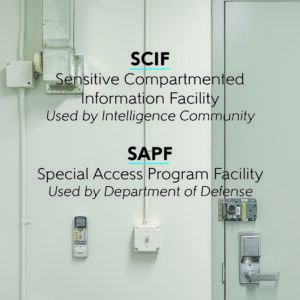These high-security facilities look the same and can serve the same function, but the difference between a SCIF and SAPF lies in who utilizes the facility.
SCIFs, Sensitive Compartmented Information Facilities, and SAPFs, Special Access Program Facilities, are two types of secure facilities whose names are sometimes used interchangeably. However, they have one major difference: While both are U.S. government-accredited facilities designed to store, discuss or process classified or sensitive information, and both are built according to the same technical specifications, the difference is found in who utilizes these facilities.
SAPFs are most often used by the Department of Defense (i.e., the intelligence organizations of the U.S. Navy, U.S. Army, U.S. Air Force, U.S. Marine Corps and U.S. Coast Guard) to house Special Access Programs, or SAP, while SCIFs are used by the Intelligence Community for handling Sensitive Compartmented Information, or SCI. Here are the Intelligence Community, or IC, elements that use SCIFS:
- Central Intelligence Agency
- Defense Intelligence Agency
- Department of Energy
- Department of Homeland Security
- Department of State
- Department of the Treasury
- Drug Enforcement Administration
- Federal Bureau of Investigation
- National Geospatial-Intelligence Agency
- National Reconnaissance Office
- National Security Agency
- Office of the Director of National Intelligence
SCIF and SAPF Construction Standards
The difference between SCIFs and SAPFs is often confused because both facilities adhere to the special construction requirements set forth by the ICD 705 Technical Specifications for Construction and Management of Sensitive Compartmented Information Facilities, otherwise known as the Tech Spec. But it wasn’t always this way.
In 2004, the Department of Defense began using its own standards, processes and ways of protecting national security with the use of a document titled the JAFAN 6/9. And prior to 2010, when the Intelligence Community Directive number 705 (ICD 705) policy debuted, each agency inside the Intelligence Community had their own standards when it came to classified information. This was problematic because if a company received a contract to build a SCIF for the NSA and then later wanted to use that same space for a contract with the CIA, they couldn’t

SCIFs and SAPFs both protect sensitive information, just for different organizations.
utilize the same facility without a major renovation because these agencies had different standards and specifications for safeguarding their information.
Soon after the ICD 705 was published, the technical standards that were attached to the policy were released for industry use through the Tech Spec. These specifications, which laid out standards for everything from wall construction to locking hardware and approved types of access control systems, provided a uniform set of standards that all SCIFs could be built to. So now, thanks to the Tech Spec, if a SCIF is built for the NSA it can later be repurposed for the CIA, or any other IC elements if needed, because the facility would meet the standards for all.
In 2016, the Department of Defense joined the Intelligence Community in using the Tech Spec as they adopted it through the DoD manual 5205.7. With the issuance of this manual, there are now two policy documents pointing toward using the Tech Spec, one for non-DoD Intelligence Community elements (ICD 705) and the other for the DoD elements. This created a major shift toward reciprocity, or mutually accepted standards, among all Intelligence Community elements and military branches.
Although built to the same standard, many of the SAPF procedural standards for accrediting a facility still do not align with the ICD 705 accrediting processes; however, the two have never been more reciprocal than they are today.
If you’d like to learn more about the construction standards of SCIFs and SAPFs, you can request a free PDF copy of the IC Tech Spec V1.5.1. If you’d like to learn more about what goes into the development of a SCIF or SAPF, Adamo offers education courses to teach you the process, pitfalls and policy for an accredited facility and equips you with the tools and knowledge to apply directly to your own project.




